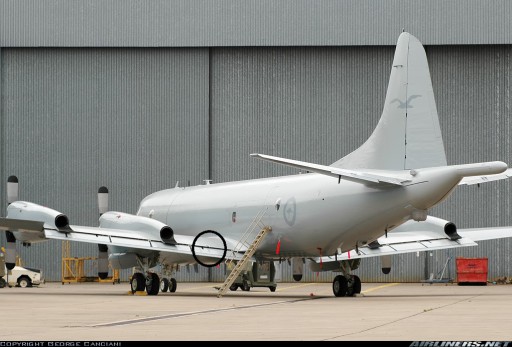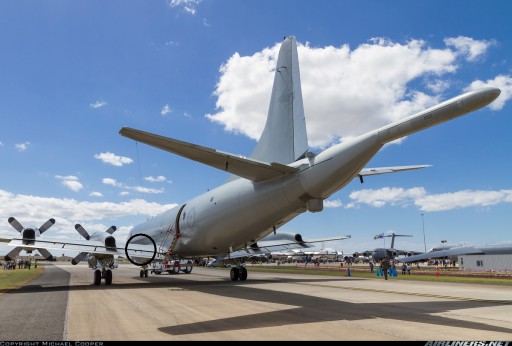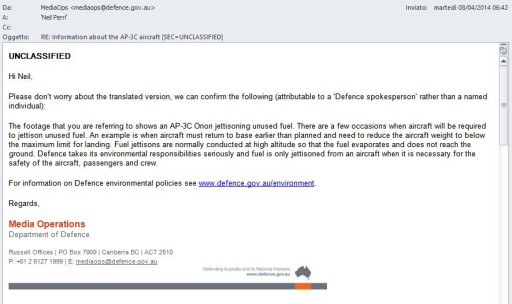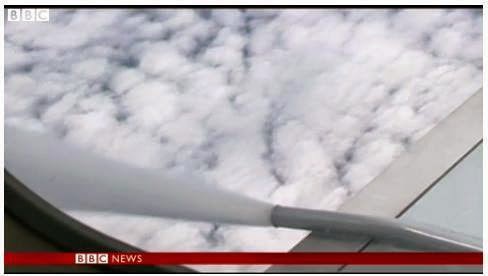La prova delle scie chimiche?
We have an english version for the following story. Scroll down the page to read it!
Un miliardo di blog di pseudo-news e geniacci del web ci mostrano la “pistola fumante” della teoria delle scie chimiche. Non so se sono i primi ma Informatitalia si è profusa anche nel dare la spiegazione da parte di Gianni Lannes a riguardo.
Nell’ambito di un servizio sull’aereo misteriosamente scomparso in Malaysia la celebre emittente BBC mostra un video dove si vede chiaramente un tubo posto sopra l’ala dell’aereo che disperde “fumo bianco”; le immagini sono chiare, e non lasciano spazio ad interpretazione. E’ evidente che non si tratta del motore del velivolo, anche se essendo il tubo ubicato nell’ala, sotto la quale sono posti anche i motori, da terra può dare l’impressione che sia il motore a rilasciare la scia…
Ecco il dettaglio
E qui potete vedere il servizio proposto dalla BBC il 28 Marzo
http://www.bbc.com/news/world-asia-26782637?SThisFB
Non c’è dubbio che da un “tubo” sta uscendo qualcosa, ma è fumo?
Ora aspettiamo che i soliti debunker vengano a fornire una “spiegazione ufficiale”, ma ormai la frittata è fatta. MAI fino ad oggi erano state mostrate immagini di questo tipo, così come è evidente che su nessun velivolo – di linea o militare – siano presenti tubi come quello che si vede nel video, che emettono fumo bianco..
Eccoci, arriviamo. La questione è di per se più semplice di quello che sembra. Le immagini mostrate sono state registrate a bordo di un aereo Lockheed Martin P-3C Orion della aviazione australiana che partecipa alla ricerca del oramai famoso volo MH370. Quello che si vede nel filmato non è la creazione di una scia chimica per geoingegneria, ma un episodio di fuel dumping. E che cos’è? Il fuel dumping è una pratica che si utilizza per alleggerire un velivolo in vista di un atterraggio: ogni aereo ha un peso massimo oltre il quale l’atterraggio è pericoloso o almeno rischioso. Nella norma un aereo arrivando a destinazione ha consumato il carburante necessario per arrivarci quindi il peso è inferiore a quello di partenza, ma se per qualche motivo deve fermarsi prima bisogna potersi alleggerire. Ci sono 3 modi per affrontare il problema: il fuel dumping (che semplicemente significa “gettare il carburante”), oppure volare in condizioni di alto attrito (come per esempio in configurazione di atterraggio) che permette quindi di consumare più carburante ma con tempi maggiori del fuel dumping, oppure semplicemente atterrare in condizioni di peso maggiore, con tutti i rischi connessi. Quindi è vero che nessun velivolo ha un tubo per emettere fumo, ma hanno degli scarichi per il carburante.
Il carburante per via della altitudine e pressione non rimane liquido, ma fuoriesce come lo vediamo nel filmato, come se fosse spruzzato. Ovviamente questa spiegazione non soddisfa chi deve vedere i complotti in ogni dove e si avvale quindi della consulenza di un grande esperto come Gianni Lannes
Il fuel dumping è una manovra d’emergenza con la quale, in caso di necessità, può essere rilasciato il combustibile in eccesso prima di effettuare un atterraggio. La manovra non viene effettuata in nessun caso in condizioni ordinarie e viene utilizzata esclusivamente in situazioni di reale pericolo.
In genere il fuel dumping viene effettuato immediatamente dopo il decollo nel caso l’aeromobile dovesse riatterrare qualora si fosse effettuato un guasto che non permettesse di proseguire la manovra di decollo. A pieno carico infatti in caso di un atterraggio da effettuare immediatamente dopo il decollo, quando i serbatoi del cherosene sono ancora pressoché pieni e il peso eccessivo dell’apparecchio potrebbe causare un cedimento strutturale dei carrelli, si effettua la manovra del fuel dumping.
In genere gli aeromobili attrezzati per il fuel dumping sono di grandi dimensioni, mentre quelli di piccole e medie dimensioni, nei quali il peso massimo al decollo non differisce eccessivamente dal peso massimo all’atterraggio, non vengono dotati di un sistema di questo tipo. A partire dagli anni sessanta tutti gli aeromobili nei quali il peso massimo al decollo differisce per più del 5% da quello all’atterraggio devono essere dotati, secondo la vigente normativa rilasciata dal FAA, di un sistema per il rilascio del combustibile in volo.
Prendendo per buoni i dati che riporta, dagli anni ’60 tutti i velivoli che hanno una differenza di peso di più del 5% tra decollo e atterraggio devono essere dotati di un sistema di rilascio del combustibile in volo. Ho il sospetto che una buona parte degli aerei in circolazione abbiano questo sistema allora, e il nostro Orion ne è dotato. Nei voli, soprattutto quelli di linea, il carburante è calcolato perché i costi sono importanti, ma quello ripreso era uno dei voli alla ricerca del relitto dello scomparso MH370. Quindi hanno soldi da buttare? NO, semplicemente il 27 Marzo le condizioni meteorologiche avverse non permisero all’aereo di controllare la zona corretta e dovendo tornare indietro decisero di alleggerirsi in volo per poter atterrare in sicurezza (probabilmente anche un problema ad uno dei motori). Come confermato anche da un membro del sito www.p3orion.nl, specializzato su quel modello di aereo, quello ripreso non è altro che
it’s the fuel dump nozzle, which is standard on the P-3C model.
È lo scarico per il carburante, standard sul modello P-3C.
come riportato dal sito Sovereign Indipendent UK , altro sito filo complottista ma che almeno ha fatto un po’ di ricerca invece che guardare le immagini sul computer e additare con forza sparando sentenze.
Quindi in soldoni: quell’aereo può fare il fuel dump, qui un esempio del 2011 (scorrete la pagina verso il fondo), non sono solo i grossi aerei di linea a poterlo fare, aveva la necessità di farlo, e il cameraman ha semplicemente mostrato quello che succedeva.
Negare la realtà dei fatti non è una prova. Ritentate, magari la prossima volta sarete più fortunati. O magari imparate e collegare il cervello prima di scrivere.
Aggiornamento 05/04/2014
Dato che qualcuno mi ha sfidato a trovare una foto dove si veda questo ugello, eccola

Qua si vede un po’ meno, ma si intravede

Le foto sono specifiche per il modello AP-3C, che è quello in dotazione alla RAAF Australiana, che è il modello visto nel video della BBC. Di questo aereo ne esistono una miriade di versioni. Non sono un esperto, ma credo che in base alla versione dell’aereo potrebbe esserci o meno questo ugello, sospetto che possa essere presente nei modelli che sono stati modernizzatati dopo gli anni ’90. Come possiamo leggere qui su wikipedia i 18 mezzi della RAAF sono stati aggiornati dal 1997 al 2005, con notevoli migliorie soprattutto a bordo. Altra cosa importante: un tubo di 10-15 cm di diametro è un dettaglio molto piccolo da vedere in una foto che deve contenere un aereo di oltre 30 metri di apertura alare e in base al dettaglio, risoluzione e compressione del file potrebbe sfuggire o addirittura scomparire.
La cosa che mi rende un po’ triste e che, come spesso accade, quando il “super scoop”, da titolare possibilmente con INCREDIBILE, si smonta da solo (chiaramente l’aereo stava facendo fuel dumping con un tubo apposito per quello) bisogna mutare complotto. Si è partiti con un “Ecco vedete che ci sono aerei che fanno le scie chimiche??” e “Solo gli aerei di linea fanno il fuel dumping” a “La BBC è in combutta col Governo quindi ci fanno vedere apposta un fuel dumping facendo dire alla gente che sia una scia chimica così da sputtanare l’dea delle irrorazioni clandestine” (sono i concetti a grandi linee che ho visto).
[…] s’intende, la gente che li vede o è tutta scema o ha le allucinazioni.
Parole tue, non mie…Lannes trovati un lavoro invece di consumare spazio su Internet.
Aggiornamento 08/04/2014
Dopo aver contattato il ministero della difesa Australiano, chiedendo delucidazioni sull’argomento, ho ottenuto questa risposta (avrei preferito qualche dettaglio in più, ma non mi lamento troppo)
The footage that you are referring to shows an AP-3C Orion jettisoning unused fuel. There are a few occasions when aircraft will be required to jettison unused fuel. An example is when aircraft must return to base earlier than planned and need to reduce the aircraft weight to below the maximum limit for landing. Fuel jettisons are normally conducted at high altitude so that the fuel evaporates and does not reach the ground. Defence takes its environmental responsibilities seriously and fuel is only jettisoned from an aircraft when it is necessary for the safety of the aircraft, passengers and crew.For information on Defence environmental policies see www.defence.gov.au/environment.Regards,
Media Operations
Department of Defence
Russell Offices | PO Box 7909 | Canberra BC | ACT 2610
P: +61 2 6127 1999 | E: mediaops@defence.gov.au

Traduzione per gli english impaired
Il filmato al quale ti riferisci mostra una AP-3C Orion che scarica del carburante non utilizzato. Ci sono alcune situazioni nel quale un velivolo possa avere bisogno di scaricare del carburante. Per esempio se l’aereo deve ritornare alla base prima di quanto pianificato per ridurre il perso sotto il limite di sicurezza per l’atterraggio. Lo scarico del carburante viene effettuato ad una altitudine elevata così che evapori e non raggiunga il suolo. La Difesa è molto seria sulle proprie responsabilità ambientali e lo scarico del carburante dagli aerei viene effettuato solo quando necessario per salvaguardare la sicurezza dell’aereo, passeggeri ed equipaggio.
Per maggiori informazioni sulle politiche ambientali della Difesa potete guardare a www.defence.gov.au/environment.
Quindi la Difesa Australiana conferma tutto quanto abbiamo detto finora. Direi che il caso è chiuso.
__________________________________________________________________________________________________________________
ENGLISH VERSION
First I want to apologize for my english, it was a fast translation so the Australian Defence spokeman could give me a reply, but it may be the first of many stories in english for BUTAC 🙂
The proof of chemtrails?
A billion of creepy blogs and web geniuses have found the “smoking gun” of the chemtrails cospiracy theory. I don’t know if they were the first, but Informatitalia even tried to give an extended explanation using Gianni Lannes words.
In a reportage about the plane that has misteriously disappered in Malaysia, the famous BBC shown a video where you can clearly see a pipe on the wing that is scattering a “white smoke”; the images are clear, and there is no space for doubt or speculation. It’s clear that it is not from the engine, even if it being on the wing near the engines it could seem from below that it may be engine releasing the trail…
Here in detail

And here you can find the reportage from BBC the 28 March
http://www.bbc.com/news/world-asia-26782637?SThisFB
No doubt that something is being released from the “pipe”, but what is it?
Now we are wating the usual debunkers that will give us the “official explanation”, but the damage has been done. NEVER before something like this has been shown, and it is clear that no aircraft – military or not – have pipes like that shown that release white smoke…
Here we are. The issue is more simple that it may appear. The video shown has been recorded on board of a Lockheed Martin P-3C Orion of the Australian Air Force that is helping in the search of the now infamous MH370 flight. What we are looking at is not the genesis of a chemtrail for geo-engineering, but just a fuel dumping. What is it? The fuel dumping is a procedure used by planes to unburden themselves to land safer: every aircraft has a maximum weight beyond which the landing is dangerous or at least risky. Usually a plane that has reached it’s destination has already used all the fuel needed so the final weight is lower that the initial, but if for some reason it needs to stop earlier it may need to ger lighter. There are 3 ways to resolve the issue: the fuel dumping (eliminating the excess of fuel), flying in a landing configuration so that more fuel can be used, but in a slower manner than the fuel dumping, or just land. with the overweight with all the risks involved. So while it is true that no plane has pipes to release smoke, thay may have it to release fuel.
The fuel seems sprayed and not liquid for the pressure and temperature. Obviously who sees cospiracy everywhere is not satisfied by this explanation and therefore relies on the advice of such an expert like Gianni Lannes:
The fuel dumping is an emergency maneuver, with which, in case of need, the excess of fuel can be released before making a landing. The operation is not performed in any case under ordinary conditions and is only used in situations of real danger
Typically, the fuel dumping is carried out immediately after takeoff in case the aircraft should land in case of a failure that does not allow it to continue the take-off maneuver. In case of a landing to be carried out immediately after take off, at full load when the tanks of kerosene are still almost full, the excessive weight of the unit may cause structural failure of the trolleys, so the maneuver of the fuel dumping is carried out.
Typically aircraft equipped for dumping the fuel are only large ones, while those of small and medium dimensions where the maximum takeoff weight does not differ too much from the maximum landing weight are not equipped with a system of this type. Since the ‘60 all the aircraft in which the maximum takeoff weight differs by more than 5% from the landing weight shall be equipped, in accordance with existing regulations issued by the FAA, with a system for realease of the fuel in-flight.
Let’s take his words for good, so every aircraft that have a delta of weight of 5% from take off to landing should be capable of the fuel dumping maneuver. I think that this means that almost every plane may have it, and the Orion has it. On long flights the fuel is calculated scrupulously because costs are very important, but that was one of the flights in search of the wreck of the late MH370. Does it mean that they have money to burn? NO, but on the 27th of March adverse weather conditions did not allow the aircraft to check the correct zone and having to go back they decided to lighten up in the air to land safely (maybe there was an issue with one of the engines?). Like a member of the site www.p3orion.nl confimerd it is simply this:
it’s the fuel dump nozzle, which is standard on the P-3C model.
like the Sovereign Indipendent UK is reporting. It is a cospiracy web site but at least they did some research instead of only pointing fingers. A recap: that plane can to a fuel dump, here and example of the 2011 (scroll down the page for the photo), and not only the big aircrafts, and the reporter just shown what was happening.
To deny the reality is not “proof”. Try again, maybe next time you’ll be more lucky. Or maybe try to connect the brain before writing.
Update 05/04/2014
Since someone has challenged me to find a picture where you see the nozzle, here it is

Or here even if a little bit harder to see

These are photos of the AP-3C variant, the one used by the Australian RAAF, and it is the plane seen on the BBC video. There are a lot of versions of this plane. I’m no expert, but I think that depending on the version of the plane there may be or not be the fuel dump nozzle, present expecially on those updated after the ’90. Like it is reported on wikipedia the 18 planes of the RAAF were upgraded between 1997 and 2005 with a lot of upgrades. Very important is that a relatively small pipe can get lost in a digital picture of a 30m large plane depending on the quality, resolution and compression ratio of the picture.
What saddens me is that, like usual, when an “incredible scoop” gets debunked (it is clear that the plane was doing a fuel dump with a nozzle made for that) the cospiracy evolves. Started as a “don’t you see it? The proof of chemtrails!” and “Only big planes do fuel dumping” it went to “BBC is showing a fuel dumping only to make people think about chemtrails to slag the chemtrail theory”.
[…]of course, the people who sees them or it’s stupid or has hallucinations.
Your words, not mine…Lannes find yourself a job instead of wasting space on internet.
Update 08/04/2014
We’ve got this reply from a spokeperson of the Australian Defence:
The footage that you are referring to shows an AP-3C Orion jettisoning unused fuel. There are a few occasions when aircraft will be required to jettison unused fuel. An example is when aircraft must return to base earlier than planned and need to reduce the aircraft weight to below the maximum limit for landing. Fuel jettisons are normally conducted at high altitude so that the fuel evaporates and does not reach the ground. Defence takes its environmental responsibilities seriously and fuel is only jettisoned from an aircraft when it is necessary for the safety of the aircraft, passengers and crew.For information on Defence environmental policies see www.defence.gov.au/environment.Regards,
Media Operations
Department of Defence
Russell Offices | PO Box 7909 | Canberra BC | ACT 2610
P: +61 2 6127 1999 | E: mediaops@defence.gov.au
Ricordatevi di amare col cuore, ma per tutto il resto di usare la testa.
neilperri @ butac.it
Se ti è piaciuto l’articolo, sostienici su Patreon o su PayPal! Può bastare anche il costo di un caffè!








